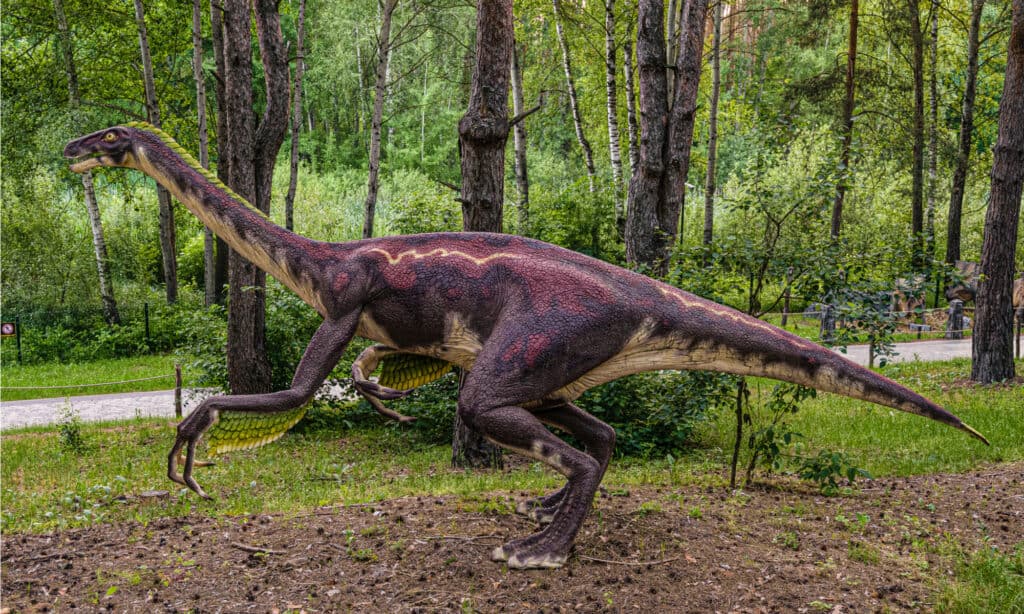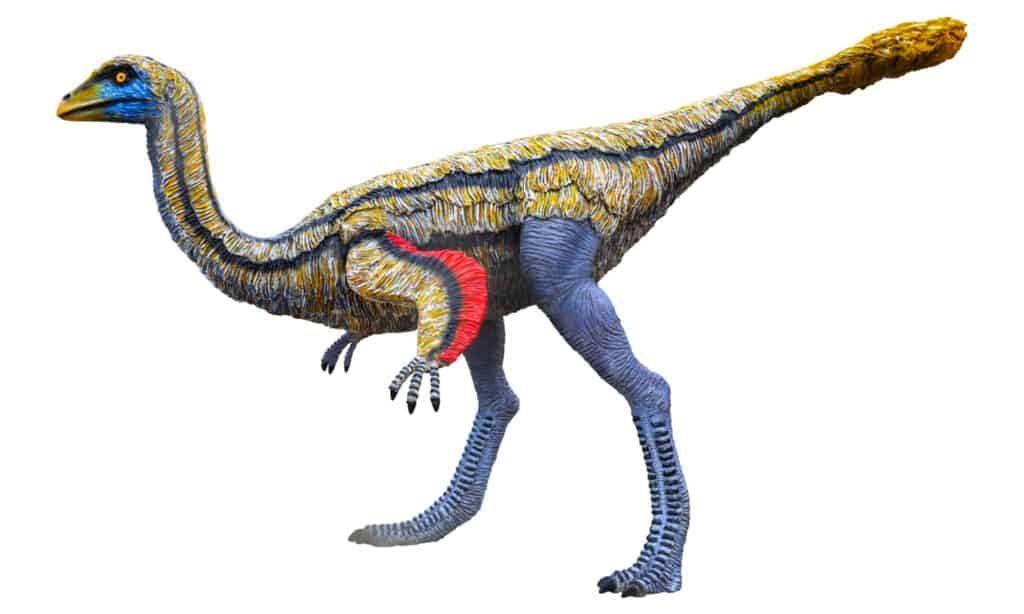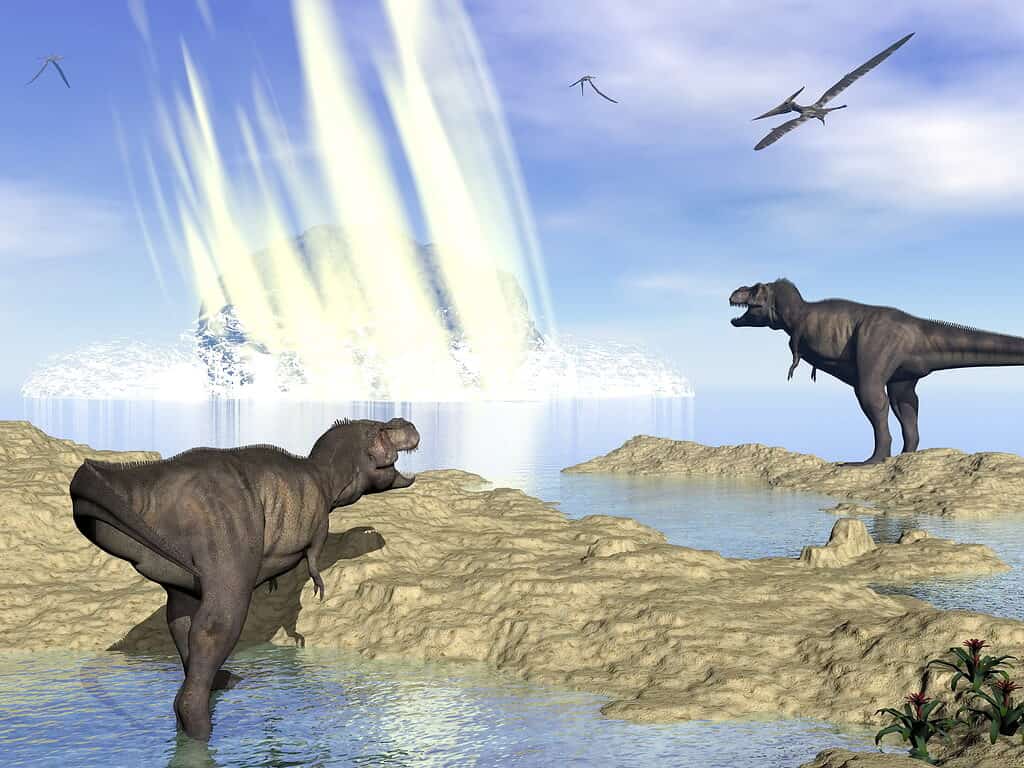Dinosaurs came in many shapes and sizes throughout history. While some of them were gigantic herbivores, others resembled creatures that are alive now. In fact, one dinosaur resembled an ancient ostrich, and it would tower over all but the tallest human beings. Learn how big this dinosaur grew, when it lived, and what caused it to go extinct!
What Was the Ancient Ostrich Dinosaur?

had long arms and hands with curved necks.
©N-sky/Shutterstock.com
The ancient ostrich dinosaur was part of a genus called Ornithomimus. The theropod genus had two species Ornithomimus velox and Ornithomimus edmontonicus. To be clear, this species was a dinosaur and not a bird. However, the name Ornithomimus may certainly cause some confusion. After all, the translation for this term is “bird mimic.” While scientists believe that this creature somewhat resembled a bird, it was a reptile.
The dinosaur was interesting because it had many features that are similar to a bird. The creature had a lightly built body with hollow bones, two long legs, a long neck, a small, toothless beaked skull, and feathers. At first glance, it may have passed for an ancient ostrich.
This creature had arms that it used to grasp and hold prey. Also, it had long, powerful legs that would have been great for running, allowing them to swiftly hunt prey. Scientists estimate this dinosaur could have reached speeds of 40 mph while running! However, it was not as agile as ostriches and other modern flightless birds.
Ornithomimus also had a long tail complete with bones. That contributed to the dinosaur’s length and would have made it appear larger and more formidable.
How Big Did Ornithomimus Get?

Ornithomimus had hair-like feathers along their legs, neck, and lower torso.
©SciePro/Shutterstock.com
Ornithomimus was much larger than any modern ostrich. Ornithomimus edmontonicus was the larger of the two species. This creature measured about 12 feet long and about 6 feet tall on average, but some sources claim they reached about 7 feet tall and almost 20 feet long! Scientists estimate that Ornithomimus weighed somewhere in the area of 370 pounds.
That makes the creature rather large, but it’s not quite as tall as a typical ostrich. These modern flightless birds can stand between 5.6 and 9.2 feet tall on average. They’re also very heavy animals that weigh between 140 and 320 pounds.
Ornithomimus wasn’t the largest theropod dinosaur, but it was still larger than some other notable dinosaurs.
Was Ornithomimus Bigger than a Velociraptor?
Yes, Ornithomimus was larger than the Velociraptor species. When many people see the name Velociraptor, they imagine the creature from the Jurassic Park films. Those dinosaurs were far larger and scarier than the real Velociraptor.
In fact, Ornithomimus’ actual size is close to the size of Velociraptor from the films. Standing between 6 and 7 feet tall and measuring 12 feet long on average is near to the films’ portrayal. Meanwhile, the actual Velociraptor was rather diminutive.
The dinosaurs could grow about 6 feet long and stand about 1.5 feet tall at the hip. Most of the time, they would weigh about 30 pounds. Rather than a large, fierce killing machine, this dinosaur was about the size of a turkey. Still, it had long claws that would have made it a capable hunter.
While Ornithomimus was not the largest dinosaur, it was still sizable.
When Was the Ancient Ostrich Alive?

dinosaurs had a similar appearance to the modern ostrich.
©YuRi Photolife/Shutterstock.com
Ornithomimus lived from about 125 million years ago until 66 million years ago. This era is called the Late Cretaceous Period. Scientists determined the age of the fossils by their location. The first fossils of Ornithomimus were found in the Denver Formation of Colorado.
Since then, scientists have located fossils of this dinosaur in several other places in North America including Montana, Arizona, and even in parts of Alberta, Canada.
By the end of the Cretaceous Period, these dinosaurs were all wiped out.
Why Did Ornithomimus Go Extinct?

The Chicxulub asteroid impacted Yucatan, Mexico and ended the age of the dinosaurs.
©Elenarts/Shutterstock.com
Ornithomimus went extinct around 66 million years ago. Unlike many other species of dinosaurs without a definitive reason for their extinction, scientists have a very good idea about this ancient ostrich’s fate.
About 66 million years ago, a disaster struck the planet and wiped out all non-avian dinosaurs. A large asteroid impacted the Yucatan Peninsula. This was called the Cretaceous-Paleogene extinction, and it was the fifth major extinction to affect the planet that humans know about today.
The dinosaurs didn’t suddenly die at the moment of impact. However, the asteroid strike caused an impact winter. That is when a vast amount of dirt, ash, and other material is suddenly ejected into the atmosphere. As a result, a limited amount of sunlight can get through the cloud. With plant life dying off worldwide, the food chain started to collapse.
Just about all the tetrapod creatures that weighed over 55 pounds died off during this event as well as every species of terrestrial dinosaur that was left. Ornithomimus succumbed at some point during this event. By the time the dust settled, roughly 75% of the species on the planet had died off.
The bird mimic that resembled an ancient ostrich was an interesting dinosaur. Still, there is a great deal about these dinosaurs that scientists don’t know, including their diet. While they were theropods and had all the makings of a carnivore, some people insist that they were omnivores.
Also, scientists aren’t certain about some other aspects of their lifestyle, like whether they were diurnal or nocturnal. Future discoveries will help scientists unravel the mystery of the Ornithomimus.
The photo featured at the top of this post is © Jose Angel Astor Rocha/Shutterstock.com
Thank you for reading! Have some feedback for us? Contact the AZ Animals editorial team.






